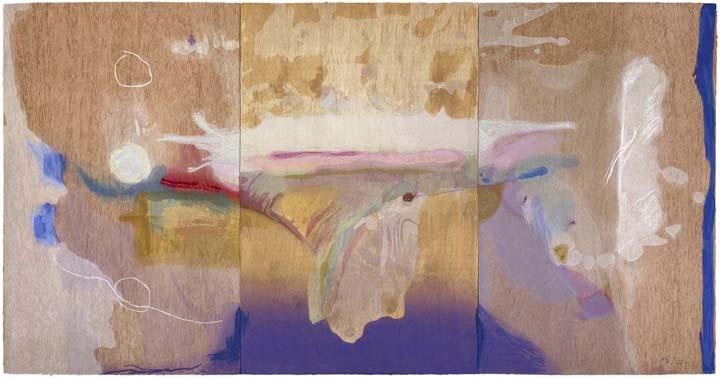Helen Frankenthaler at The Clark
Among the great artists of mid-century America, Helen Frankenthaler is now receiving a share of recognition long overdue. Currently featured in MoMAs Making Space: Women Artists and Postwar Abstraction, and in a solo show at Gagosian, Paris, two sides of the artist’s formidable output are further explored in exhibitions opening this weekend at The Clark Institute, in Williamstown, Massachusetts.
As in Nature: Helen Frankenthaler Paintings, presents works from across five decades that explore the artist’s connection with the natural world as a point of departure for her abstractions. Frankenthaler experimented tirelessly in her painting, always seeking to develop new styles, materials, and techniques. She sometimes alluded to nature directly, in paintings that refer to natural themes or even specific places, and sometimes indirectly, through colors, forms, and textures. Her early forays into the “soak-stain” process that she pioneered in 1952 can be traced to her residency at nearby Bennington College the previous year, during which she worked directly from nature to develop her abstractions.
During the 1950s, Frankenthaler developed that influential technique, in which she poured thinned paint directly onto raw, unprimed canvas laid on the studio floor. This approach allowed her to layer washes of paint on top of one another, creating unusual combinations of colors and forms and blurring the traditional distinction between figure and ground. Writing about Frankenthaler in 1972, art critic Barbara Rose, spoke of “the freedom, spontaneity, openness and complexity of an image, not exclusively of the studio or the mind, but explicitly and intimately tied to nature and human emotions.”
In Frankenthaler’s later work, her interest in landscape continued, with many of her paintings assuming the horizontal format of traditional landscape art. Off White Square (1973), above, is a monumental canvas measuring roughly twenty-five feet in width. The canvas is mostly covered in the artist’s typical thin, horizontal washes of color, but also contains uncharacteristic geometric abstractions such as the off-white square referred to in the title. Above: Off White Square, 1973. Acrylic on canvas. From the Louis-Dreyfus Family Collection, courtesy of the William Louis-Dreyfus Foundation Inc. © 2017 Helen Frankenthaler Foundation, Inc. / Artists Rights Society (ARS), New York. Photo below: Ernst Haas/Getty Images.
Above: Madame Butterfly, 2000. 102-color woodcut from forty-six woodblocks on three sheets of handmade paper, 41 3/4 x 79 1/2 in. Helen Frankenthaler Foundation © 2017 Helen Frankenthaler Foundation, Inc. / Artists Rights Society (ARS), New York / Tyler Graphics Ltd., Mount Kisco, New York

In 1983, Frankenthaler traveled to Japan and worked with the expert woodcarver Reizo Monjyu and the printer Tadashi Toda. Frankenthaler continued to experiment in Freefall (1993), working with dyed paper-pulp printed with color blocks to create layers of color. Here she made the paper by hand-dying the pulp in various colors. The size of Freefall—over 6.5 x 5 feet—is significant in its own right. To create a sheet of paper this large is a feat, and to complicate it further by adding twenty-one woodblocks illustrates Frankenthaler’s ability to push the boundaries of the medium.
As in Nature: Helen Frankenthaler Paintings and No Rules: Helen Frankenthaler Woodcuts open Saturday, July 1, continuing through September 24. The Clark Institute, 225 South Street, Williamstown, Massachusetts. Info
Ed note: much of the info here is derived from The Clark's press release PRreview





